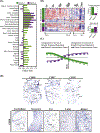Prenatal Origins of ASD: The When, What, and How of ASD Development
- PMID: 32353336
- PMCID: PMC7373219
- DOI: 10.1016/j.tins.2020.03.005
Prenatal Origins of ASD: The When, What, and How of ASD Development
Abstract
Autism spectrum disorder (ASD) is a largely heritable, multistage prenatal disorder that impacts a child's ability to perceive and react to social information. Most ASD risk genes are expressed prenatally in many ASD-relevant brain regions and fall into two categories: broadly expressed regulatory genes that are expressed in the brain and other organs, and brain-specific genes. In trimesters one to three (Epoch-1), one set of broadly expressed (the majority) and brain-specific risk genes disrupts cell proliferation, neurogenesis, migration, and cell fate, while in trimester three and early postnatally (Epoch-2) another set (the majority being brain specific) disrupts neurite outgrowth, synaptogenesis, and the 'wiring' of the cortex. A proposed model is that upstream, highly interconnected regulatory ASD gene mutations disrupt transcriptional programs or signaling pathways resulting in dysregulation of downstream processes such as proliferation, neurogenesis, synaptogenesis, and neural activity. Dysregulation of signaling pathways is correlated with ASD social symptom severity. Since the majority of ASD risk genes are broadly expressed, many ASD individuals may benefit by being treated as having a broader medical disorder. An important future direction is the noninvasive study of ASD cell biology.
Keywords: autism; brain specific; broadly expressed; gene; prenatal; proliferation; regulatory; synapse.
Copyright © 2020 The Authors. Published by Elsevier Ltd.. All rights reserved.
Figures





References
-
- Dawson G, et al. (2004) Early social attention impairments in autism: social orienting, joint attention, and attention to distress. Dev Psychol 40, 271–283 - PubMed
-
- Fodstad JC, et al. (2009) Social and communication behaviours in infants and toddlers with autism and pervasive developmental disorder-not otherwise specified. Dev Neurorehabil 12, 152–157 - PubMed
-
- Matson JL, et al. (2010) The effects of inattention/impulsivity and ASD symptom severity on social skills in toddlers. Dev Neurorehabil 13, 408–412 - PubMed
-
- Elsabbagh M, et al. (2011) Social and attention factors during infancy and the later emergence of autism characteristics. Prog Brain Res 189, 195–207 - PubMed
-
- Lombardo MV, et al. (2011) Specialization of right temporo-parietal junction for mentalizing and its relation to social impairments in autism. Neuroimage 56, 1832–1838 - PubMed

